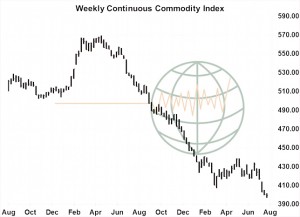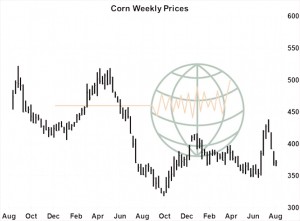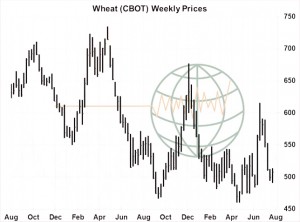Weekly CCI Analysis:
The CCI/CRB bounced on Friday but settled the week at new multi-year lows. The plunge continues to be driven by weak energy and metal prices, with only limited rallies in ag markets offsetting this. We maintain a longer term bearish outlook as the US$ has not yet peaked. The July US employment report featured the addition of 215,000 new jobs, which was close to expectations but which also validates a rate hike from the Feb sometime in early autumn. The US$ consolidated late in the week, but near rally highs and concern over China and South American economies persists. Crop production, specifically, will likely expand outside of the US amid renewed weakness in currencies in the Black Sea and Brazil, and crude’s decline has not triggered the necessary improvement in consumption.

Longer-term soybean analysis:
Soybean futures held in a narrow range for much of the week, but were higher at Friday’s close on short covering ahead of the August crop report, and drier than desired weather forecasts across the Eastern Midwest. New crop export sales were the largest of the year at just over 1 million mt, and there were also announcements of several more cargos sold to China through the week. However, new crop sales remain well behind last year, and indicate that the USDA could be overestimating soybean exports by 150-200 million bu. Market focus in the week ahead will be on the August crop report. Ahead of the report, the average trade estimate calls for a soybean crop of 3.7 billion bu, barely under last year’s record crop. Our view is that once the crop report has passed, market focus will turn towards slow export sales and building US stocks. We continue to remain bearish on any strong rallies ahead of harvest.

Longer-term corn analysis:
Corn futures this week ended up 3 cents. Critical USDA supply updates lie in the offing, and ahead of next week’s Crop Report, and FSA acreage data the following week, speculative funds have defended what is still a very large net long position. Bullish numbers in the comings weeks are needed to prevent additional long liquidation, but the theme is that US supply (and associated risks) have returned to the forefront of trading strategies. We maintain a longer term bearish outlook amid recent crop condition rating improvements, and as demand shows little sign of improving. S American corn is still offered below US Gulf values into late autumn, and there’s increasing market talk of aggressive Brazilian ethanol exports following a further drop in their currency and very cheap sugar prices. End user demand underpins prices on breaks, but 2015/16 stocks/use forecasts of 14% implies harvest lows of $3.50-3.60, basis December. Supply-driven into early September offer selling opportunities.

Longer-term wheat analysis:
US wheat futures settled the week mixed, with Dec Chicago up 11, KC up 2 and MGE down 1. HRW’s discount to SRW continues to expand amid burdensome supplies and as Gulf fob prices are some $30-40/mt amid competing origins. This HRW discount will be a feature in spot months in the foreseeable future. Otherwise, there’s little change. Egypt’s latest tender again confirmed that major world exporters are searching hard for demand, and Black Sea and EU cash prices have fallen to seasonal lows. Russian domestic prices are in decline amid winter harvest and favourable spring wheat conditions – and the Ruble posted a new multi-month low this week, which makes Russian wheat that much more competitive. The overreaching theme remains too much supply chasing too little demand, and US end stocks of 925- 950 million bu argue against any sustained rally in the months ahead. Better export and feed consumption is needed. A range of $4.80-5.30, spot, is projected into autumn.


